Strategic Innovation: Dyson's Practices for Business Development
VerifiedAdded on 2023/06/10
|12
|3583
|124
Report
AI Summary
This project report provides a detailed analysis of Dyson's innovative practices within the retail industry, highlighting how these practices contribute to the company's strategic growth and development. It identifies Dyson's capabilities in demonstrating innovation, particularly in its expertise business, and examines the application of an organizational culture framework and strategic innovation management. The report discusses future industry trends, including the increasing importance of sustainability and the expansion into new markets like electric vehicles and digital technologies. It also emphasizes the need for collaboration, implementation, and value creation in organizational innovation, along with Dyson's efforts to enhance its digital presence and customer experience through strategic partnerships and technology adoption. Furthermore, the report delves into Handy's cultural dimension to understand Dyson's organizational culture, focusing on power and task cultures and their impact on decision-making and team collaboration within the company.
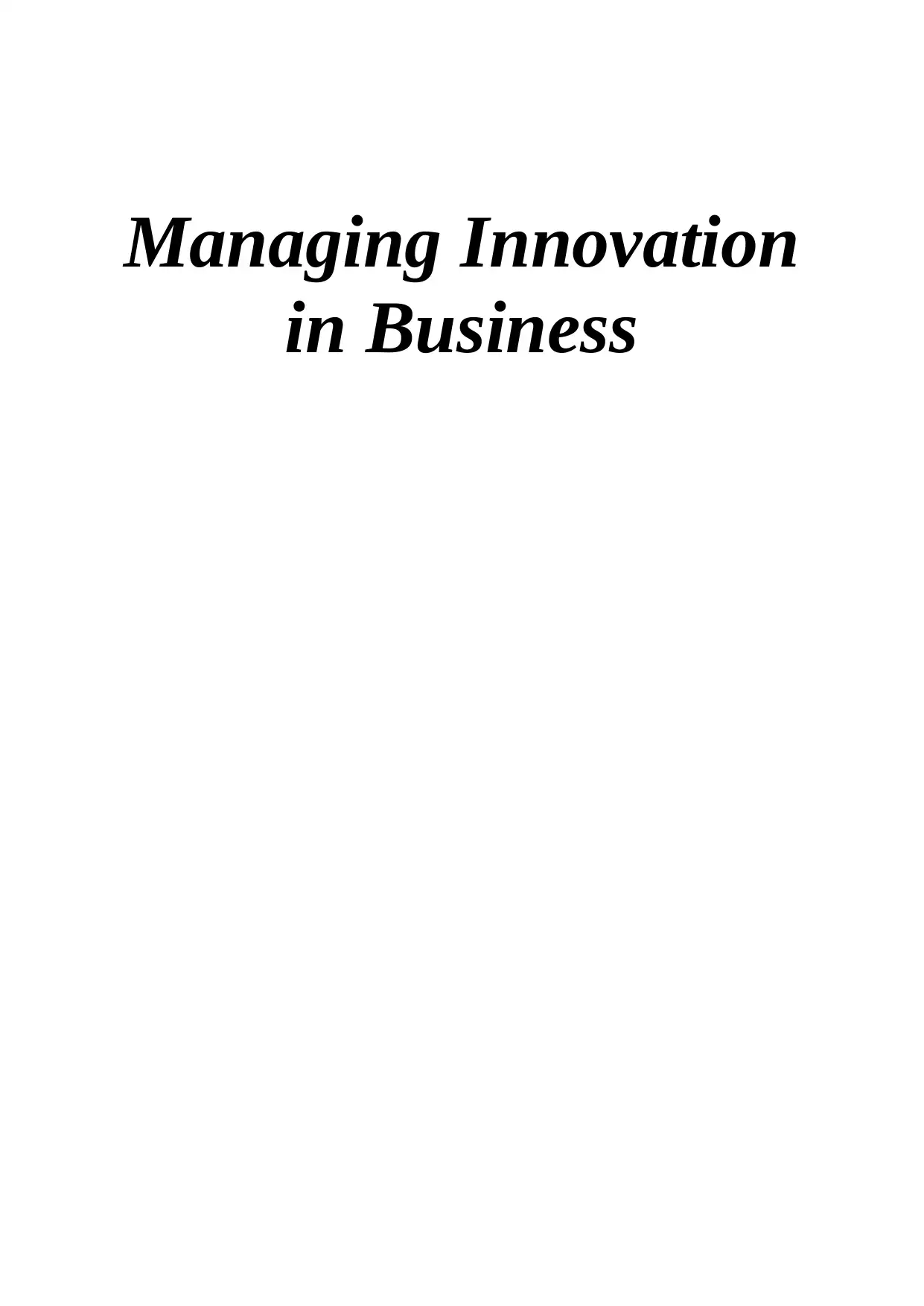
Managing Innovation
in Business
in Business
Paraphrase This Document
Need a fresh take? Get an instant paraphrase of this document with our AI Paraphraser
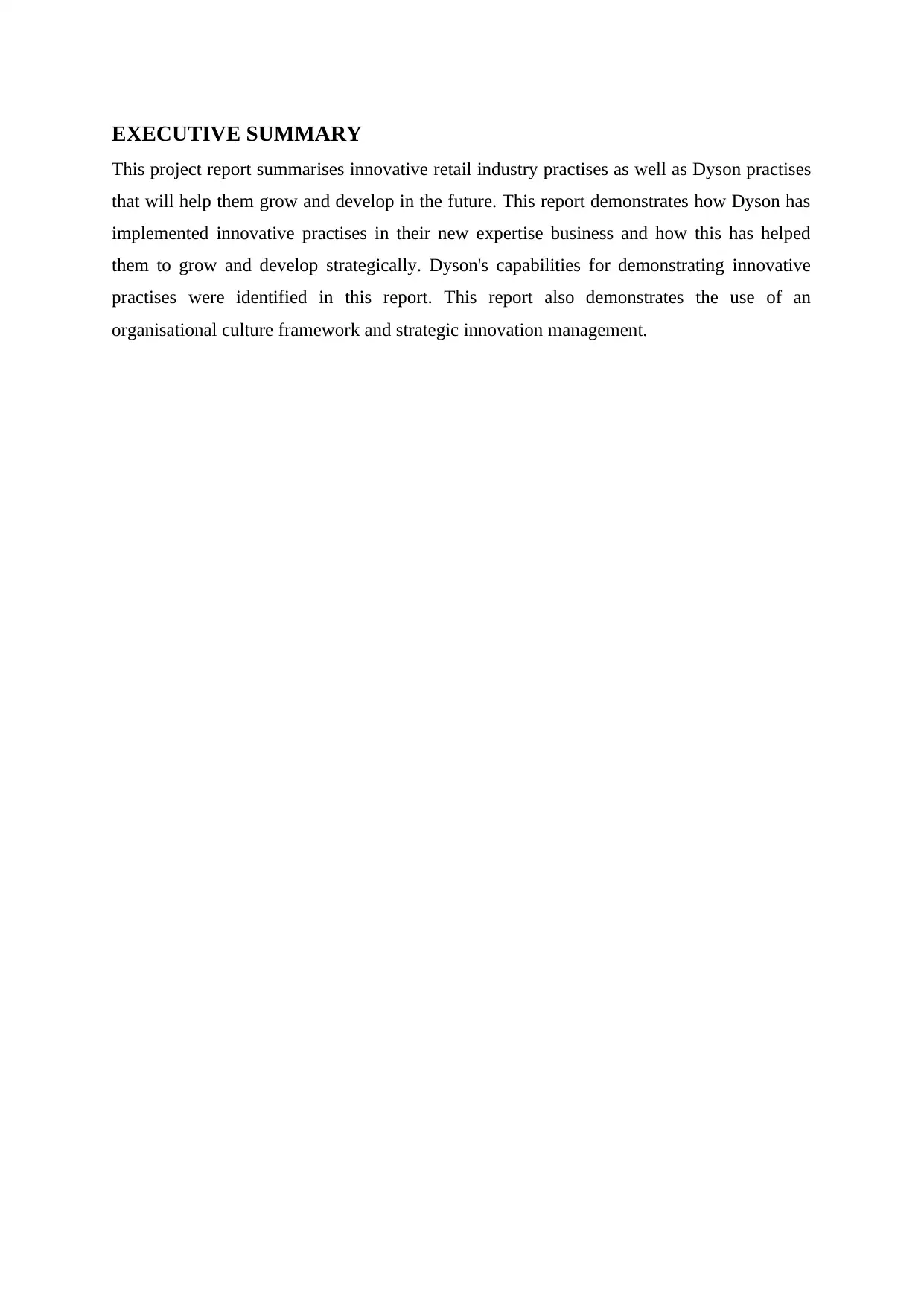
EXECUTIVE SUMMARY
This project report summarises innovative retail industry practises as well as Dyson practises
that will help them grow and develop in the future. This report demonstrates how Dyson has
implemented innovative practises in their new expertise business and how this has helped
them to grow and develop strategically. Dyson's capabilities for demonstrating innovative
practises were identified in this report. This report also demonstrates the use of an
organisational culture framework and strategic innovation management.
This project report summarises innovative retail industry practises as well as Dyson practises
that will help them grow and develop in the future. This report demonstrates how Dyson has
implemented innovative practises in their new expertise business and how this has helped
them to grow and develop strategically. Dyson's capabilities for demonstrating innovative
practises were identified in this report. This report also demonstrates the use of an
organisational culture framework and strategic innovation management.
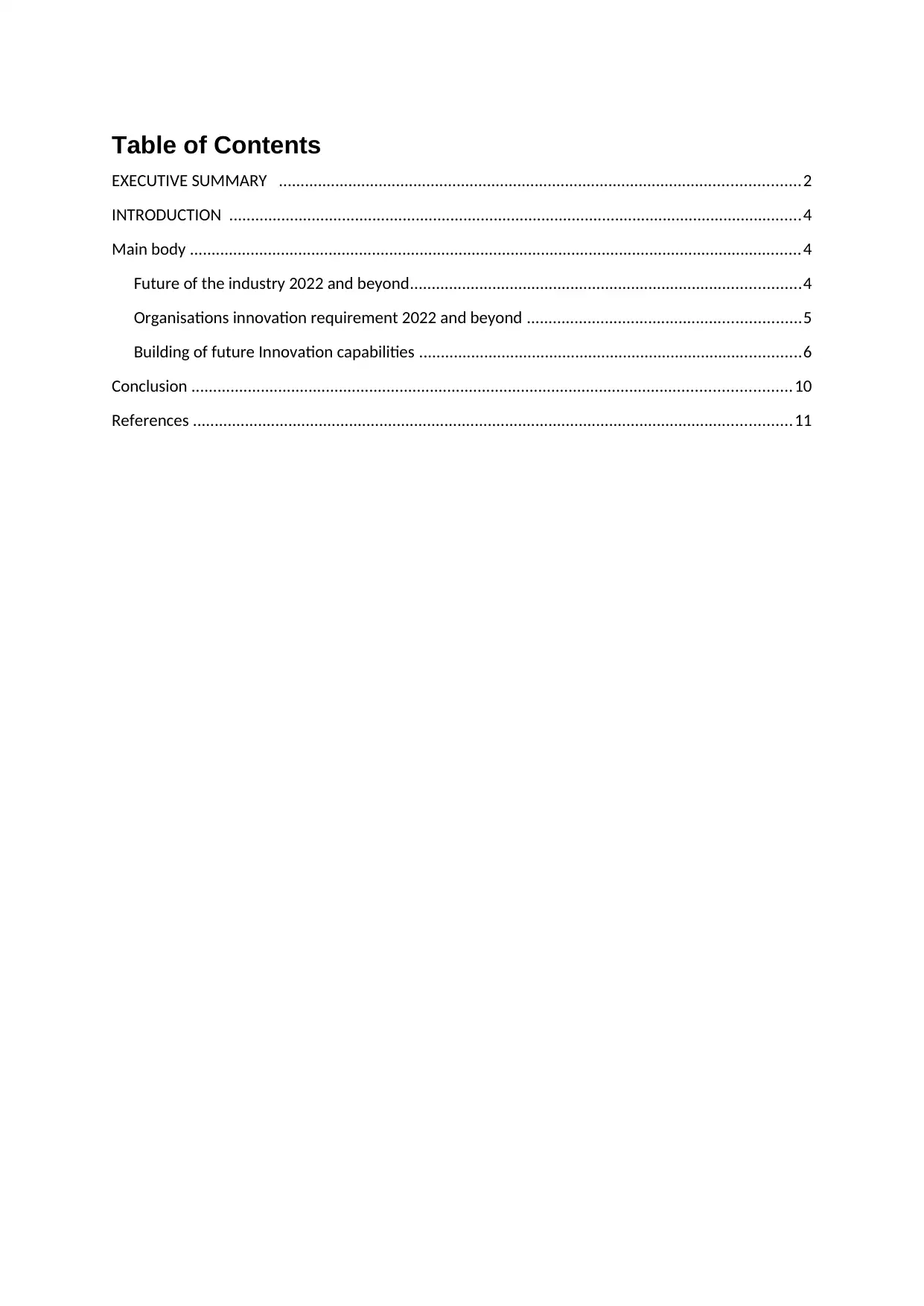
Table of Contents
EXECUTIVE SUMMARY ........................................................................................................................2
INTRODUCTION ....................................................................................................................................4
Main body .............................................................................................................................................4
Future of the industry 2022 and beyond..........................................................................................4
Organisations innovation requirement 2022 and beyond ...............................................................5
Building of future Innovation capabilities ........................................................................................6
Conclusion ..........................................................................................................................................10
References ..........................................................................................................................................11
EXECUTIVE SUMMARY ........................................................................................................................2
INTRODUCTION ....................................................................................................................................4
Main body .............................................................................................................................................4
Future of the industry 2022 and beyond..........................................................................................4
Organisations innovation requirement 2022 and beyond ...............................................................5
Building of future Innovation capabilities ........................................................................................6
Conclusion ..........................................................................................................................................10
References ..........................................................................................................................................11
⊘ This is a preview!⊘
Do you want full access?
Subscribe today to unlock all pages.

Trusted by 1+ million students worldwide
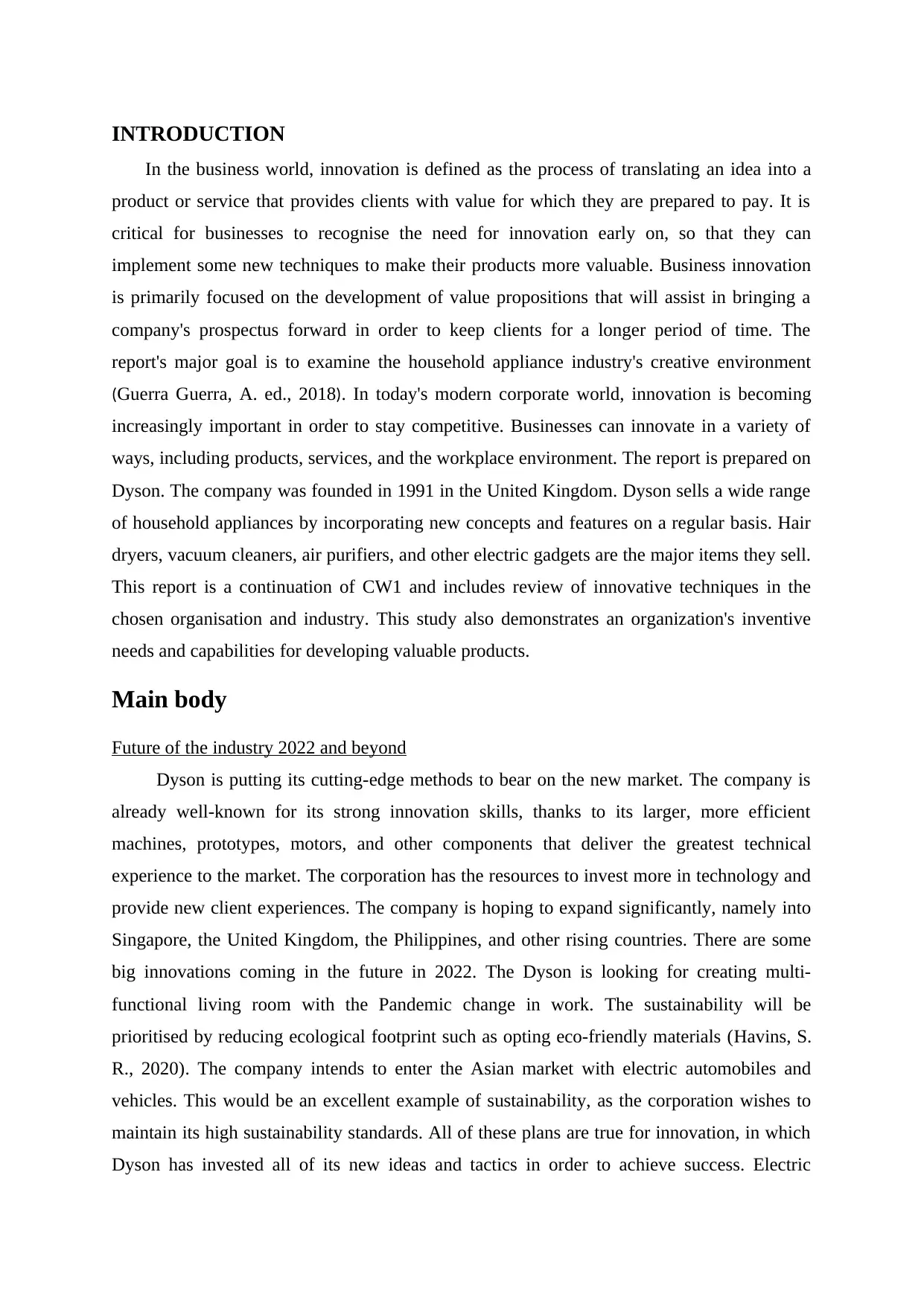
INTRODUCTION
In the business world, innovation is defined as the process of translating an idea into a
product or service that provides clients with value for which they are prepared to pay. It is
critical for businesses to recognise the need for innovation early on, so that they can
implement some new techniques to make their products more valuable. Business innovation
is primarily focused on the development of value propositions that will assist in bringing a
company's prospectus forward in order to keep clients for a longer period of time. The
report's major goal is to examine the household appliance industry's creative environment
(Guerra Guerra, A. ed., 2018). In today's modern corporate world, innovation is becoming
increasingly important in order to stay competitive. Businesses can innovate in a variety of
ways, including products, services, and the workplace environment. The report is prepared on
Dyson. The company was founded in 1991 in the United Kingdom. Dyson sells a wide range
of household appliances by incorporating new concepts and features on a regular basis. Hair
dryers, vacuum cleaners, air purifiers, and other electric gadgets are the major items they sell.
This report is a continuation of CW1 and includes review of innovative techniques in the
chosen organisation and industry. This study also demonstrates an organization's inventive
needs and capabilities for developing valuable products.
Main body
Future of the industry 2022 and beyond
Dyson is putting its cutting-edge methods to bear on the new market. The company is
already well-known for its strong innovation skills, thanks to its larger, more efficient
machines, prototypes, motors, and other components that deliver the greatest technical
experience to the market. The corporation has the resources to invest more in technology and
provide new client experiences. The company is hoping to expand significantly, namely into
Singapore, the United Kingdom, the Philippines, and other rising countries. There are some
big innovations coming in the future in 2022. The Dyson is looking for creating multi-
functional living room with the Pandemic change in work. The sustainability will be
prioritised by reducing ecological footprint such as opting eco-friendly materials (Havins, S.
R., 2020). The company intends to enter the Asian market with electric automobiles and
vehicles. This would be an excellent example of sustainability, as the corporation wishes to
maintain its high sustainability standards. All of these plans are true for innovation, in which
Dyson has invested all of its new ideas and tactics in order to achieve success. Electric
In the business world, innovation is defined as the process of translating an idea into a
product or service that provides clients with value for which they are prepared to pay. It is
critical for businesses to recognise the need for innovation early on, so that they can
implement some new techniques to make their products more valuable. Business innovation
is primarily focused on the development of value propositions that will assist in bringing a
company's prospectus forward in order to keep clients for a longer period of time. The
report's major goal is to examine the household appliance industry's creative environment
(Guerra Guerra, A. ed., 2018). In today's modern corporate world, innovation is becoming
increasingly important in order to stay competitive. Businesses can innovate in a variety of
ways, including products, services, and the workplace environment. The report is prepared on
Dyson. The company was founded in 1991 in the United Kingdom. Dyson sells a wide range
of household appliances by incorporating new concepts and features on a regular basis. Hair
dryers, vacuum cleaners, air purifiers, and other electric gadgets are the major items they sell.
This report is a continuation of CW1 and includes review of innovative techniques in the
chosen organisation and industry. This study also demonstrates an organization's inventive
needs and capabilities for developing valuable products.
Main body
Future of the industry 2022 and beyond
Dyson is putting its cutting-edge methods to bear on the new market. The company is
already well-known for its strong innovation skills, thanks to its larger, more efficient
machines, prototypes, motors, and other components that deliver the greatest technical
experience to the market. The corporation has the resources to invest more in technology and
provide new client experiences. The company is hoping to expand significantly, namely into
Singapore, the United Kingdom, the Philippines, and other rising countries. There are some
big innovations coming in the future in 2022. The Dyson is looking for creating multi-
functional living room with the Pandemic change in work. The sustainability will be
prioritised by reducing ecological footprint such as opting eco-friendly materials (Havins, S.
R., 2020). The company intends to enter the Asian market with electric automobiles and
vehicles. This would be an excellent example of sustainability, as the corporation wishes to
maintain its high sustainability standards. All of these plans are true for innovation, in which
Dyson has invested all of its new ideas and tactics in order to achieve success. Electric
Paraphrase This Document
Need a fresh take? Get an instant paraphrase of this document with our AI Paraphraser
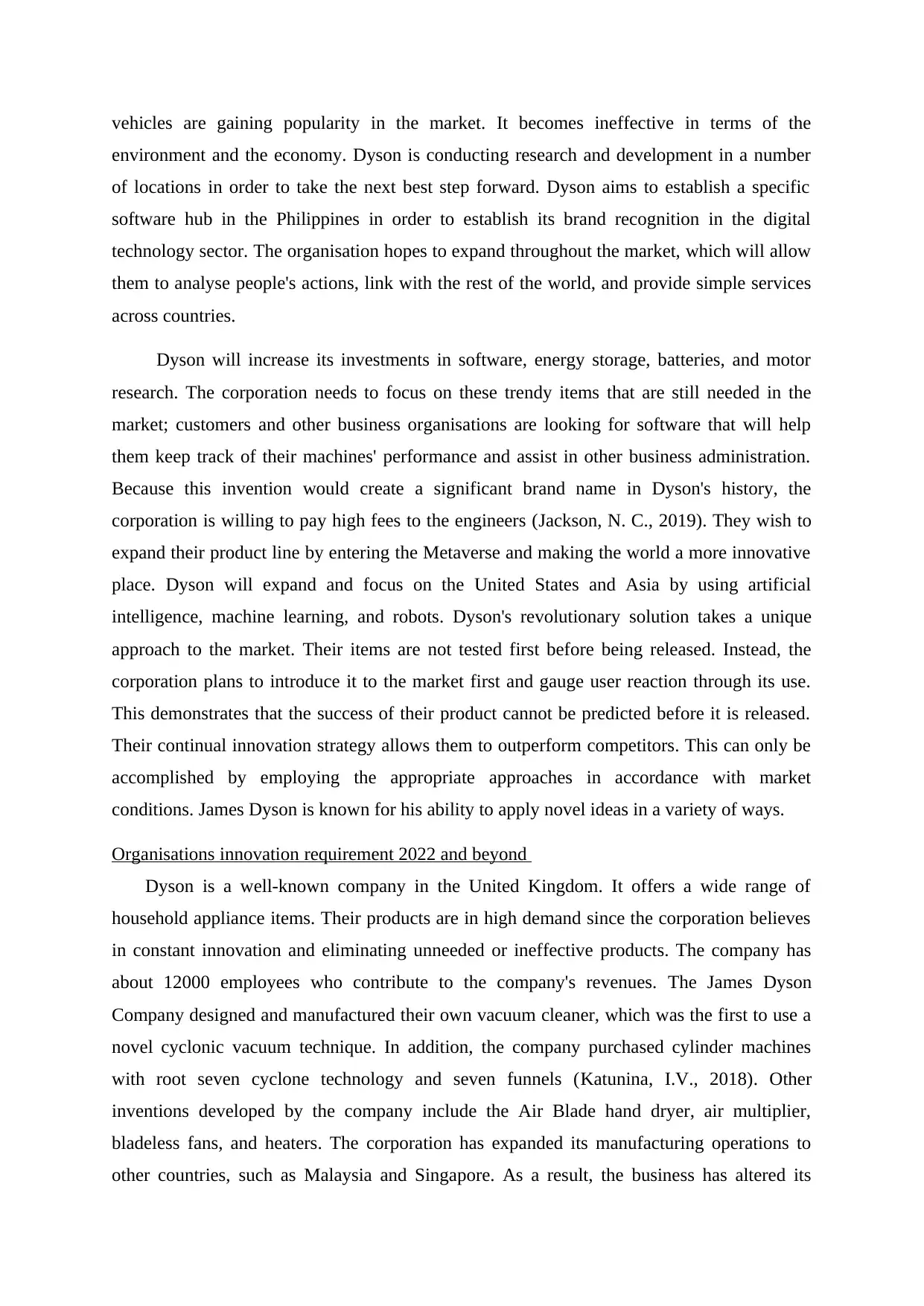
vehicles are gaining popularity in the market. It becomes ineffective in terms of the
environment and the economy. Dyson is conducting research and development in a number
of locations in order to take the next best step forward. Dyson aims to establish a specific
software hub in the Philippines in order to establish its brand recognition in the digital
technology sector. The organisation hopes to expand throughout the market, which will allow
them to analyse people's actions, link with the rest of the world, and provide simple services
across countries.
Dyson will increase its investments in software, energy storage, batteries, and motor
research. The corporation needs to focus on these trendy items that are still needed in the
market; customers and other business organisations are looking for software that will help
them keep track of their machines' performance and assist in other business administration.
Because this invention would create a significant brand name in Dyson's history, the
corporation is willing to pay high fees to the engineers (Jackson, N. C., 2019). They wish to
expand their product line by entering the Metaverse and making the world a more innovative
place. Dyson will expand and focus on the United States and Asia by using artificial
intelligence, machine learning, and robots. Dyson's revolutionary solution takes a unique
approach to the market. Their items are not tested first before being released. Instead, the
corporation plans to introduce it to the market first and gauge user reaction through its use.
This demonstrates that the success of their product cannot be predicted before it is released.
Their continual innovation strategy allows them to outperform competitors. This can only be
accomplished by employing the appropriate approaches in accordance with market
conditions. James Dyson is known for his ability to apply novel ideas in a variety of ways.
Organisations innovation requirement 2022 and beyond
Dyson is a well-known company in the United Kingdom. It offers a wide range of
household appliance items. Their products are in high demand since the corporation believes
in constant innovation and eliminating unneeded or ineffective products. The company has
about 12000 employees who contribute to the company's revenues. The James Dyson
Company designed and manufactured their own vacuum cleaner, which was the first to use a
novel cyclonic vacuum technique. In addition, the company purchased cylinder machines
with root seven cyclone technology and seven funnels (Katunina, I.V., 2018). Other
inventions developed by the company include the Air Blade hand dryer, air multiplier,
bladeless fans, and heaters. The corporation has expanded its manufacturing operations to
other countries, such as Malaysia and Singapore. As a result, the business has altered its
environment and the economy. Dyson is conducting research and development in a number
of locations in order to take the next best step forward. Dyson aims to establish a specific
software hub in the Philippines in order to establish its brand recognition in the digital
technology sector. The organisation hopes to expand throughout the market, which will allow
them to analyse people's actions, link with the rest of the world, and provide simple services
across countries.
Dyson will increase its investments in software, energy storage, batteries, and motor
research. The corporation needs to focus on these trendy items that are still needed in the
market; customers and other business organisations are looking for software that will help
them keep track of their machines' performance and assist in other business administration.
Because this invention would create a significant brand name in Dyson's history, the
corporation is willing to pay high fees to the engineers (Jackson, N. C., 2019). They wish to
expand their product line by entering the Metaverse and making the world a more innovative
place. Dyson will expand and focus on the United States and Asia by using artificial
intelligence, machine learning, and robots. Dyson's revolutionary solution takes a unique
approach to the market. Their items are not tested first before being released. Instead, the
corporation plans to introduce it to the market first and gauge user reaction through its use.
This demonstrates that the success of their product cannot be predicted before it is released.
Their continual innovation strategy allows them to outperform competitors. This can only be
accomplished by employing the appropriate approaches in accordance with market
conditions. James Dyson is known for his ability to apply novel ideas in a variety of ways.
Organisations innovation requirement 2022 and beyond
Dyson is a well-known company in the United Kingdom. It offers a wide range of
household appliance items. Their products are in high demand since the corporation believes
in constant innovation and eliminating unneeded or ineffective products. The company has
about 12000 employees who contribute to the company's revenues. The James Dyson
Company designed and manufactured their own vacuum cleaner, which was the first to use a
novel cyclonic vacuum technique. In addition, the company purchased cylinder machines
with root seven cyclone technology and seven funnels (Katunina, I.V., 2018). Other
inventions developed by the company include the Air Blade hand dryer, air multiplier,
bladeless fans, and heaters. The corporation has expanded its manufacturing operations to
other countries, such as Malaysia and Singapore. As a result, the business has altered its

supply chains to obtain raw resources, produce goods, and distribute them. In addition, the
company produced four million digital motors in a year for the Singapore market, generating
$11 million in sales. All of these innovations are made possible by the company's relevant
tests and research and development. Their main goal is to set high standards for customers
and provide them with simple and convenient services by serving excellent products. People
are becoming more health-conscious and focused on proper home cleaning amid the present
COVID-19 situation (Kodama, M., 2018). They're taking the first step toward a healthy
house, one free of bacteria, germs, and other hazardous particles that could affect children
and other diagnosed patients. The new vacuum cleaner has advanced sensing capabilities,
allowing it to quickly clean hair from floors and detect dust. From the design perspective
innovation start began which propose radical innovation on product. The innovation in
organisation requires collaboration, implementation and value creation. To implement the
innovation several steps are followed such as idea generation which starts from developing
new ideas where innovative practices shows thought in people minds and transforming into
reality (Mousavi and et.al., 2018). In context to Dyson it is planning to being innovative
sustainable practices in its operations. After having several ideas, next is to select desirable
idea by assessing priority that has been assessed for developing them into innovative
products. The customer are becoming more of service centric the rise in technology and
innovation is bring innovation in Dyson in its several products. This industry came into the
bigger innovations by emerging new ideas into products and services first of many companies
like Dyson has invented new motors and batteries and provide robotic solutions to give great
customer satisfaction. Innovations in household factor become vital to a great necessity for
daily routine to the individuals specially for women.
Building of future Innovation capabilities
Dyson executives are capable of securing their company's future by implementing
effective innovation practises. They are attempting to improve their digital presence in order
to make their innovation practises more efficient. Dyson executives have formed a
partnership with True, a leading innovative and investment firm in Europe, in order to gain
early access to enhance their customer expertise. Dyson is now dealing with emerging
technology, an international network, and proprietary research as a result of this strategic
alliance. True provides Dyson with a live network that allows them to manage nearly 2000
consumer technology products. Dyson executives are attempting to become successful as a
digital retailer as a result of their collaboration with True. They contribute knowledge and
company produced four million digital motors in a year for the Singapore market, generating
$11 million in sales. All of these innovations are made possible by the company's relevant
tests and research and development. Their main goal is to set high standards for customers
and provide them with simple and convenient services by serving excellent products. People
are becoming more health-conscious and focused on proper home cleaning amid the present
COVID-19 situation (Kodama, M., 2018). They're taking the first step toward a healthy
house, one free of bacteria, germs, and other hazardous particles that could affect children
and other diagnosed patients. The new vacuum cleaner has advanced sensing capabilities,
allowing it to quickly clean hair from floors and detect dust. From the design perspective
innovation start began which propose radical innovation on product. The innovation in
organisation requires collaboration, implementation and value creation. To implement the
innovation several steps are followed such as idea generation which starts from developing
new ideas where innovative practices shows thought in people minds and transforming into
reality (Mousavi and et.al., 2018). In context to Dyson it is planning to being innovative
sustainable practices in its operations. After having several ideas, next is to select desirable
idea by assessing priority that has been assessed for developing them into innovative
products. The customer are becoming more of service centric the rise in technology and
innovation is bring innovation in Dyson in its several products. This industry came into the
bigger innovations by emerging new ideas into products and services first of many companies
like Dyson has invented new motors and batteries and provide robotic solutions to give great
customer satisfaction. Innovations in household factor become vital to a great necessity for
daily routine to the individuals specially for women.
Building of future Innovation capabilities
Dyson executives are capable of securing their company's future by implementing
effective innovation practises. They are attempting to improve their digital presence in order
to make their innovation practises more efficient. Dyson executives have formed a
partnership with True, a leading innovative and investment firm in Europe, in order to gain
early access to enhance their customer expertise. Dyson is now dealing with emerging
technology, an international network, and proprietary research as a result of this strategic
alliance. True provides Dyson with a live network that allows them to manage nearly 2000
consumer technology products. Dyson executives are attempting to become successful as a
digital retailer as a result of their collaboration with True. They contribute knowledge and
⊘ This is a preview!⊘
Do you want full access?
Subscribe today to unlock all pages.

Trusted by 1+ million students worldwide

exposure to Dyson's transformation into a digital behemoth. Managers at Dyson focus on
delivering commercial results as well as a tangible return on capital to one‘s partners through
this collaboration. Dyson can improve their services by utilising the live network provided by
True Company in order to maintain a strong position in the face of changing market
conditions.
Engagement with shareholders
Dyson executives have ensured that their diverse stakeholders are satisfied through
innovative practises. They are capable of effectively engaging their stakeholders in their
operations. Dyson's stakeholders primarily include their employees, customers, suppliers, and
shareholders. They have ensured that their stakeholders are satisfied by implementing various
sustainability practises (Mousavi, Bossink and van Vliet, 2018). Dyson managers are
committed to their diverse stakeholders by providing efficient digital experiences. Dyson has
retained a commercially as well as a more technical team to support their technologically
driven business in a rational manner in order to make their digital transformation effective.
Transformation practices adopted by Dyson
Dyson executives have announced plans to virtualize their transactions in order to
become a digital business and improve their customer experiences in order to become a little
more skilled in their innovative practices. They have implemented a technology operating
model that demonstrates an understanding of industry agile methods (Perrini and Russo,
2019). They have chosen Tata Consultancy Services (TCS), a leading technology-based
company, as their technological partner. Core supplier services are routinely transferred to
TCS under this practise.
Organisational culture
Organizational culture can be defined as a set of values, perceptions, and practises
that guide and inform team members about achieving goals and objectives (Petkova, 2018). A
positive organisational culture assists managers in lowering labour turnover and increasing
employee productivity. It also contributes to the brand's identity being strong and viable. This
also promotes team collaboration and cohesion, which are regarded as essential for
implementing effective innovative practises. It is critical for organisational managers to
practise good organisational culture in order to effectively implement innovative practises.
Handy's cultural dimension is used to gain a better understanding of organisational culture.
delivering commercial results as well as a tangible return on capital to one‘s partners through
this collaboration. Dyson can improve their services by utilising the live network provided by
True Company in order to maintain a strong position in the face of changing market
conditions.
Engagement with shareholders
Dyson executives have ensured that their diverse stakeholders are satisfied through
innovative practises. They are capable of effectively engaging their stakeholders in their
operations. Dyson's stakeholders primarily include their employees, customers, suppliers, and
shareholders. They have ensured that their stakeholders are satisfied by implementing various
sustainability practises (Mousavi, Bossink and van Vliet, 2018). Dyson managers are
committed to their diverse stakeholders by providing efficient digital experiences. Dyson has
retained a commercially as well as a more technical team to support their technologically
driven business in a rational manner in order to make their digital transformation effective.
Transformation practices adopted by Dyson
Dyson executives have announced plans to virtualize their transactions in order to
become a digital business and improve their customer experiences in order to become a little
more skilled in their innovative practices. They have implemented a technology operating
model that demonstrates an understanding of industry agile methods (Perrini and Russo,
2019). They have chosen Tata Consultancy Services (TCS), a leading technology-based
company, as their technological partner. Core supplier services are routinely transferred to
TCS under this practise.
Organisational culture
Organizational culture can be defined as a set of values, perceptions, and practises
that guide and inform team members about achieving goals and objectives (Petkova, 2018). A
positive organisational culture assists managers in lowering labour turnover and increasing
employee productivity. It also contributes to the brand's identity being strong and viable. This
also promotes team collaboration and cohesion, which are regarded as essential for
implementing effective innovative practises. It is critical for organisational managers to
practise good organisational culture in order to effectively implement innovative practises.
Handy's cultural dimension is used to gain a better understanding of organisational culture.
Paraphrase This Document
Need a fresh take? Get an instant paraphrase of this document with our AI Paraphraser

It is critical for employees to collaborate in order to create an effective organisational
culture. Each organisation has adopted unique principles and values to effectively frame their
culture. Elements of Handy's cultural dimension that are relevant to Dyson are listed below:
Power culture- This culture is concerned with delegation of authority and making
critical decisions. It implies that decision-making authority should remain in some hands.
These individuals are regarded as decision-makers and powerful members of an organisation.
Employees are not given any responsibility in this culture, nor are they asked to provide any
situation (Puhan, 2019). Employees are not given the authority or responsibility to make their
own decisions. In the case of Dyson, managers do not adhere to this culture in which
employees are not given the authority to make decisions. It is critical for them to provide
adequate scope to their employees in order for them to be proactive in their approach when
implementing innovative practises. At the work place of Dyson, the power culture may cause
several issues as it bring the attitude in the managers because they are the only person in the
organisation who have authority of making decisions at work place. Along with this, it also
have some of positive impact at work place which include quick decision making along with
quick solutions to the problems.
Task culture- Teams are formed and developed here in order to achieve
organisational goals and objectives. They have the authority to make critical decisions for the
entire establishment. These teams are formed based on their areas of interest and
specialisation. Under this culture, teams must contribute equally to achieve the organization's
goals and objectives. According to Dyson, managers have formed teams for each task or
order, which allows them to achieve organisational goals more effectively. This type of
culture. Each organisation has adopted unique principles and values to effectively frame their
culture. Elements of Handy's cultural dimension that are relevant to Dyson are listed below:
Power culture- This culture is concerned with delegation of authority and making
critical decisions. It implies that decision-making authority should remain in some hands.
These individuals are regarded as decision-makers and powerful members of an organisation.
Employees are not given any responsibility in this culture, nor are they asked to provide any
situation (Puhan, 2019). Employees are not given the authority or responsibility to make their
own decisions. In the case of Dyson, managers do not adhere to this culture in which
employees are not given the authority to make decisions. It is critical for them to provide
adequate scope to their employees in order for them to be proactive in their approach when
implementing innovative practises. At the work place of Dyson, the power culture may cause
several issues as it bring the attitude in the managers because they are the only person in the
organisation who have authority of making decisions at work place. Along with this, it also
have some of positive impact at work place which include quick decision making along with
quick solutions to the problems.
Task culture- Teams are formed and developed here in order to achieve
organisational goals and objectives. They have the authority to make critical decisions for the
entire establishment. These teams are formed based on their areas of interest and
specialisation. Under this culture, teams must contribute equally to achieve the organization's
goals and objectives. According to Dyson, managers have formed teams for each task or
order, which allows them to achieve organisational goals more effectively. This type of

culture has the higher positive impact on the entire organisation of Dyson. It motivate the
people working in the Dyson to work collectively which also bring the improvement in the
overall working performance of business organisation. It also result in the achievement of
organisational goals and objectives in an effective and efficient manner as all the people with
similar interest and specialisation work collectively which leads to the improvement in the
working of employees.
Person Culture- Employees in this culture regard themselves as more important than
the organisation. Employees are more concerned with their personal interests while ignoring
organisational goals. Employees only work for money and have no attachment to the
organisation. Organizational managers at Dyson do not tolerate this type of behaviour.
Employees are given adequate opportunities to grow and develop in exchange for achieving
organisational goals and objectives. It is critical that employees prioritise organisational goals
over their own interests (Charles Handy Model of Organization Culture, 2022). Dyson's
practise of entering into effective strategic alliances enables them to bring innovations in their
processes and products. This type of culture can negatively effect the overall performance of
Dyson organisation because under this culture, the employees of business organisation, do
not focus on the goals and objectives of organisation but do focus on their self interest. They
work only for their salary and this type of culture can not bring the efficiency in the working
performance of employees and can't contribute in the achievement of organisational goals and
objectives.
Role culture – Employees or team members are assigned roles and responsibilities
based on their educational background, expertise, and interests in this culture (Sambaluk,
2018). This practise made them more innovative and productive, allowing them to achieve
organisational goals more effectively. Employees are more aware of how their organisations
work as a result of this cultural practise, and they are more willing to accept changes
introduced by organisations. Employees are held accountable and responsible for their actions
within an organisation. Employees, it is believed, must take responsibility for their actions
because power comes with accountability. According to Dyson, managers divide roles based
on their employees' expertise and specialisation, which allows them to implement innovative
practises. It is found as the best culture as it distribute the roles and responsibilities of
employees and they are own responsible for their tasks and operations as well.
people working in the Dyson to work collectively which also bring the improvement in the
overall working performance of business organisation. It also result in the achievement of
organisational goals and objectives in an effective and efficient manner as all the people with
similar interest and specialisation work collectively which leads to the improvement in the
working of employees.
Person Culture- Employees in this culture regard themselves as more important than
the organisation. Employees are more concerned with their personal interests while ignoring
organisational goals. Employees only work for money and have no attachment to the
organisation. Organizational managers at Dyson do not tolerate this type of behaviour.
Employees are given adequate opportunities to grow and develop in exchange for achieving
organisational goals and objectives. It is critical that employees prioritise organisational goals
over their own interests (Charles Handy Model of Organization Culture, 2022). Dyson's
practise of entering into effective strategic alliances enables them to bring innovations in their
processes and products. This type of culture can negatively effect the overall performance of
Dyson organisation because under this culture, the employees of business organisation, do
not focus on the goals and objectives of organisation but do focus on their self interest. They
work only for their salary and this type of culture can not bring the efficiency in the working
performance of employees and can't contribute in the achievement of organisational goals and
objectives.
Role culture – Employees or team members are assigned roles and responsibilities
based on their educational background, expertise, and interests in this culture (Sambaluk,
2018). This practise made them more innovative and productive, allowing them to achieve
organisational goals more effectively. Employees are more aware of how their organisations
work as a result of this cultural practise, and they are more willing to accept changes
introduced by organisations. Employees are held accountable and responsible for their actions
within an organisation. Employees, it is believed, must take responsibility for their actions
because power comes with accountability. According to Dyson, managers divide roles based
on their employees' expertise and specialisation, which allows them to implement innovative
practises. It is found as the best culture as it distribute the roles and responsibilities of
employees and they are own responsible for their tasks and operations as well.
⊘ This is a preview!⊘
Do you want full access?
Subscribe today to unlock all pages.

Trusted by 1+ million students worldwide
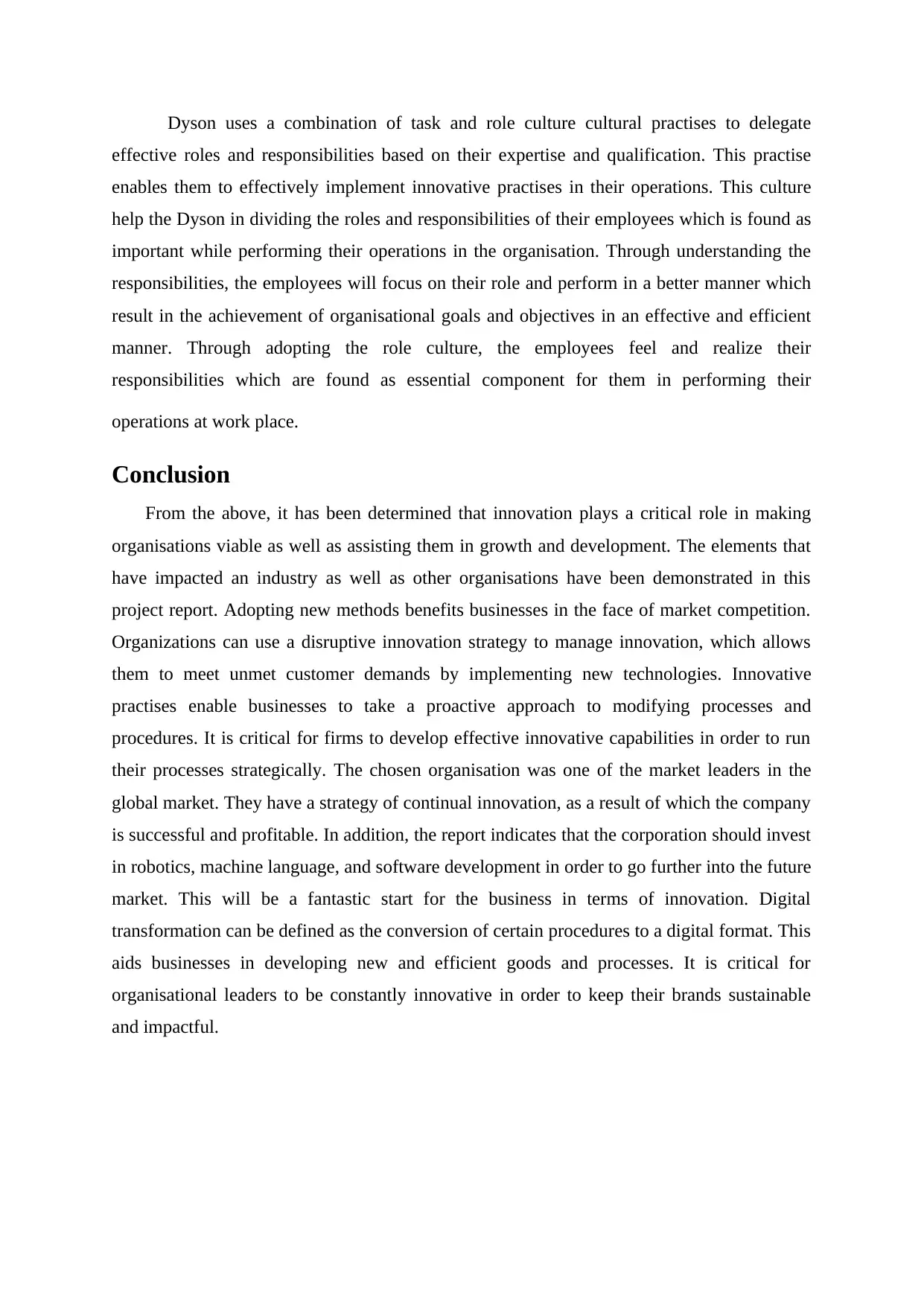
Dyson uses a combination of task and role culture cultural practises to delegate
effective roles and responsibilities based on their expertise and qualification. This practise
enables them to effectively implement innovative practises in their operations. This culture
help the Dyson in dividing the roles and responsibilities of their employees which is found as
important while performing their operations in the organisation. Through understanding the
responsibilities, the employees will focus on their role and perform in a better manner which
result in the achievement of organisational goals and objectives in an effective and efficient
manner. Through adopting the role culture, the employees feel and realize their
responsibilities which are found as essential component for them in performing their
operations at work place.
Conclusion
From the above, it has been determined that innovation plays a critical role in making
organisations viable as well as assisting them in growth and development. The elements that
have impacted an industry as well as other organisations have been demonstrated in this
project report. Adopting new methods benefits businesses in the face of market competition.
Organizations can use a disruptive innovation strategy to manage innovation, which allows
them to meet unmet customer demands by implementing new technologies. Innovative
practises enable businesses to take a proactive approach to modifying processes and
procedures. It is critical for firms to develop effective innovative capabilities in order to run
their processes strategically. The chosen organisation was one of the market leaders in the
global market. They have a strategy of continual innovation, as a result of which the company
is successful and profitable. In addition, the report indicates that the corporation should invest
in robotics, machine language, and software development in order to go further into the future
market. This will be a fantastic start for the business in terms of innovation. Digital
transformation can be defined as the conversion of certain procedures to a digital format. This
aids businesses in developing new and efficient goods and processes. It is critical for
organisational leaders to be constantly innovative in order to keep their brands sustainable
and impactful.
effective roles and responsibilities based on their expertise and qualification. This practise
enables them to effectively implement innovative practises in their operations. This culture
help the Dyson in dividing the roles and responsibilities of their employees which is found as
important while performing their operations in the organisation. Through understanding the
responsibilities, the employees will focus on their role and perform in a better manner which
result in the achievement of organisational goals and objectives in an effective and efficient
manner. Through adopting the role culture, the employees feel and realize their
responsibilities which are found as essential component for them in performing their
operations at work place.
Conclusion
From the above, it has been determined that innovation plays a critical role in making
organisations viable as well as assisting them in growth and development. The elements that
have impacted an industry as well as other organisations have been demonstrated in this
project report. Adopting new methods benefits businesses in the face of market competition.
Organizations can use a disruptive innovation strategy to manage innovation, which allows
them to meet unmet customer demands by implementing new technologies. Innovative
practises enable businesses to take a proactive approach to modifying processes and
procedures. It is critical for firms to develop effective innovative capabilities in order to run
their processes strategically. The chosen organisation was one of the market leaders in the
global market. They have a strategy of continual innovation, as a result of which the company
is successful and profitable. In addition, the report indicates that the corporation should invest
in robotics, machine language, and software development in order to go further into the future
market. This will be a fantastic start for the business in terms of innovation. Digital
transformation can be defined as the conversion of certain procedures to a digital format. This
aids businesses in developing new and efficient goods and processes. It is critical for
organisational leaders to be constantly innovative in order to keep their brands sustainable
and impactful.
Paraphrase This Document
Need a fresh take? Get an instant paraphrase of this document with our AI Paraphraser

References
Bahl, M., Lahiri, S. and Mukherjee, D., 2021. Managing internationalization and innovation
tradeoffs in entrepreneurial firms: Evidence from transition economies. Journal of
World Business. 56(1). p.101150.
Baldwin, E. and Curley, M., 2018. Managing Innovation in the Digital World. In Managing
Innovation in the Digital World. De Gruyter.
Batac, J. and Maymo, V., 2019. Managing innovation: controls and people. Recherches en
Sciences de Gestion. 130(1). pp.267-289.
Biemans, W. G., 2018. Managing innovation within networks. Routledge.
Brem, A., Tidd, J. and Daim, T. U. eds., 2019. Managing Innovation: Understanding and
Motivating Crowds (Vol. 32). World Scientific.
Gómez Montoya, D., 2018. OI innovation: Corporate business model for managing
innovation (Doctoral dissertation, Maestría en Ingeniería).
Havins, S. R., 2020. Decision Support Systems for Managing Innovation Through Project
Selection in Public Sector R&D Environments. IEEE Engineering Management
Review. 48(4). pp.28-31.
Jackson, N. C., 2019. Managing for competency with innovation change in higher education:
Examining the pitfalls and pivots of digital transformation. Business
Horizons. 62(6). pp.761-772.
Katunina, I.V., 2018. Managing innovation projects: institutional
perspective. Управленческие науки в современном мире. 1(1). pp.82-85.
Kelliher, F., Kearney, A. and Harrington, D., 2018. Managing innovation in the hospitality
micro firm: A framework for sensing, seizing and reconfiguring dynamic
capabilities. Hospitality & Society. 8(2). pp.159-178.
Mousavi, S., Bossink, B. and van Vliet, M., 2018. Dynamic capabilities and organizational
routines for managing innovation towards sustainability. Journal of cleaner
production. 203. pp.224-239.
Perrini, F. and Russo, A., 2019. The Roots of Corporate Sustainability: the Art of Managing
Innovation and Relationships by illycaffè. In Managing Sustainable Business (pp.
363-394). Springer, Dordrecht.
Petkova, I., 2018. Fashion Companies: Organizational Responses to Managing Innovation in
E-Commerce Practice. In Engineering Legitimacy (pp. 49-84). Palgrave Macmillan,
Cham.
Puhan, T. X., 2019. Managing Change and Innovation. Available at SSRN 3371800.
Sambaluk, N. M., 2018. Managing Innovation. Paths of Innovation in Warfare: From the
Twelfth Century to the Present, p.171.
Online
Bahl, M., Lahiri, S. and Mukherjee, D., 2021. Managing internationalization and innovation
tradeoffs in entrepreneurial firms: Evidence from transition economies. Journal of
World Business. 56(1). p.101150.
Baldwin, E. and Curley, M., 2018. Managing Innovation in the Digital World. In Managing
Innovation in the Digital World. De Gruyter.
Batac, J. and Maymo, V., 2019. Managing innovation: controls and people. Recherches en
Sciences de Gestion. 130(1). pp.267-289.
Biemans, W. G., 2018. Managing innovation within networks. Routledge.
Brem, A., Tidd, J. and Daim, T. U. eds., 2019. Managing Innovation: Understanding and
Motivating Crowds (Vol. 32). World Scientific.
Gómez Montoya, D., 2018. OI innovation: Corporate business model for managing
innovation (Doctoral dissertation, Maestría en Ingeniería).
Havins, S. R., 2020. Decision Support Systems for Managing Innovation Through Project
Selection in Public Sector R&D Environments. IEEE Engineering Management
Review. 48(4). pp.28-31.
Jackson, N. C., 2019. Managing for competency with innovation change in higher education:
Examining the pitfalls and pivots of digital transformation. Business
Horizons. 62(6). pp.761-772.
Katunina, I.V., 2018. Managing innovation projects: institutional
perspective. Управленческие науки в современном мире. 1(1). pp.82-85.
Kelliher, F., Kearney, A. and Harrington, D., 2018. Managing innovation in the hospitality
micro firm: A framework for sensing, seizing and reconfiguring dynamic
capabilities. Hospitality & Society. 8(2). pp.159-178.
Mousavi, S., Bossink, B. and van Vliet, M., 2018. Dynamic capabilities and organizational
routines for managing innovation towards sustainability. Journal of cleaner
production. 203. pp.224-239.
Perrini, F. and Russo, A., 2019. The Roots of Corporate Sustainability: the Art of Managing
Innovation and Relationships by illycaffè. In Managing Sustainable Business (pp.
363-394). Springer, Dordrecht.
Petkova, I., 2018. Fashion Companies: Organizational Responses to Managing Innovation in
E-Commerce Practice. In Engineering Legitimacy (pp. 49-84). Palgrave Macmillan,
Cham.
Puhan, T. X., 2019. Managing Change and Innovation. Available at SSRN 3371800.
Sambaluk, N. M., 2018. Managing Innovation. Paths of Innovation in Warfare: From the
Twelfth Century to the Present, p.171.
Online
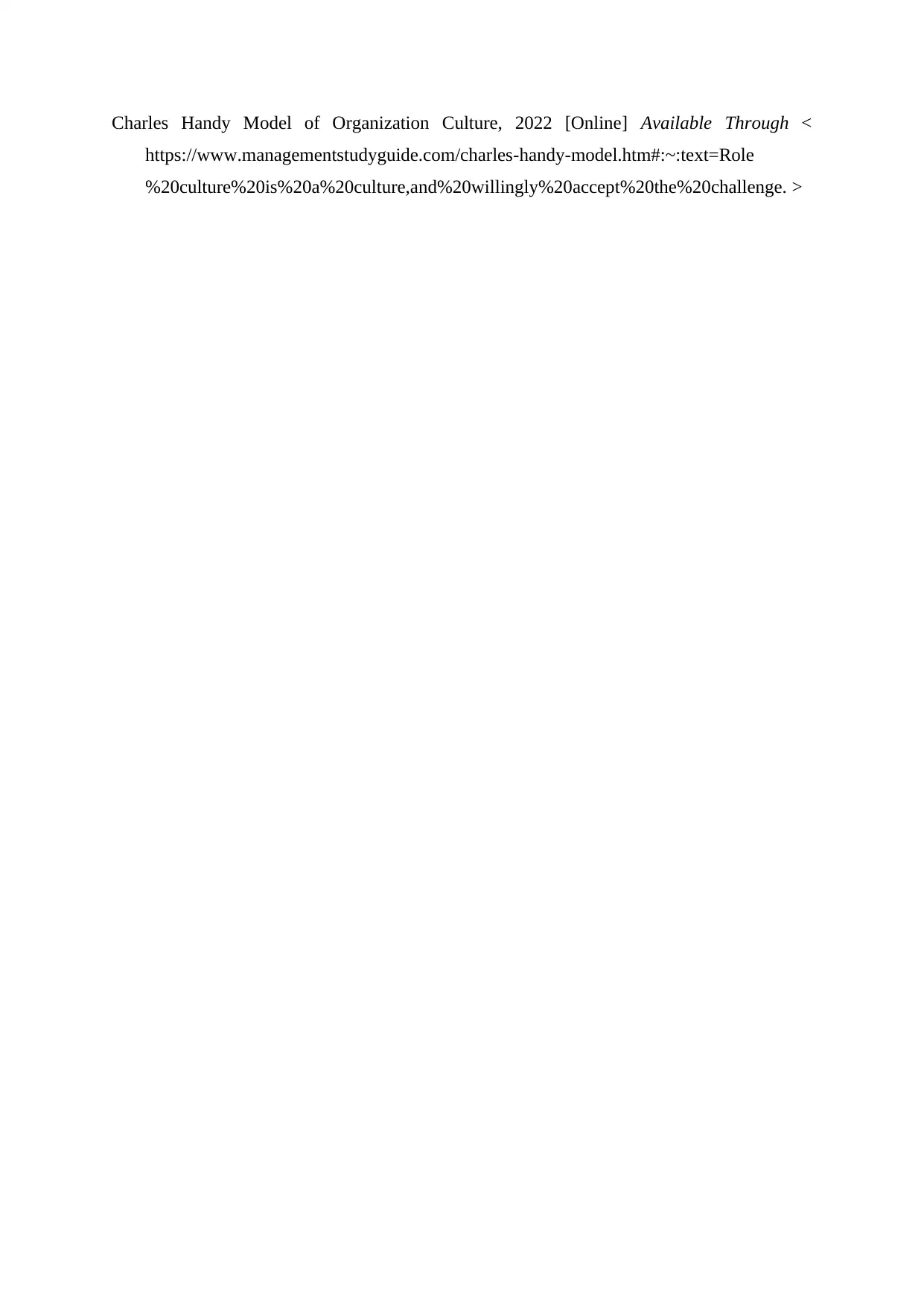
Charles Handy Model of Organization Culture, 2022 [Online] Available Through <
https://www.managementstudyguide.com/charles-handy-model.htm#:~:text=Role
%20culture%20is%20a%20culture,and%20willingly%20accept%20the%20challenge. >
https://www.managementstudyguide.com/charles-handy-model.htm#:~:text=Role
%20culture%20is%20a%20culture,and%20willingly%20accept%20the%20challenge. >
⊘ This is a preview!⊘
Do you want full access?
Subscribe today to unlock all pages.

Trusted by 1+ million students worldwide
1 out of 12
Related Documents
Your All-in-One AI-Powered Toolkit for Academic Success.
+13062052269
info@desklib.com
Available 24*7 on WhatsApp / Email
![[object Object]](/_next/static/media/star-bottom.7253800d.svg)
Unlock your academic potential
Copyright © 2020–2025 A2Z Services. All Rights Reserved. Developed and managed by ZUCOL.



